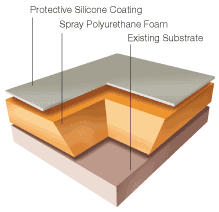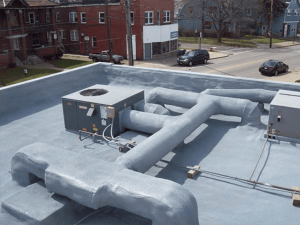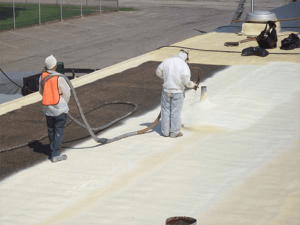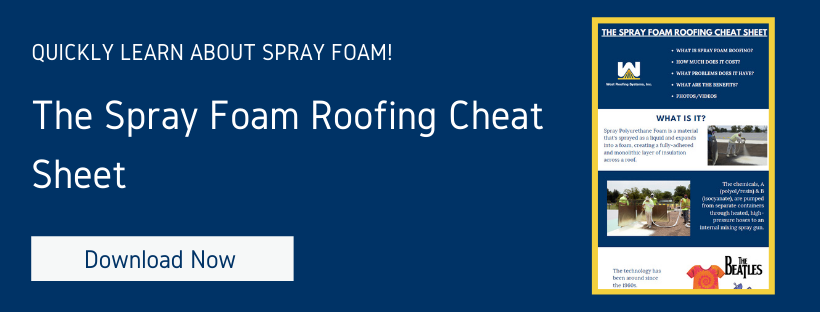If you’re asking the question ‘What is Spray Polyurethane Foam Roofing’ you’re likely new to commercial roofing or looking to replace/repair your roof.
Either way, we can help.
Here at West Roofing Systems, we’ve been installing Spray Polyurethane Foam Roofs for over 40 years. And in that time, one of the most common questions we’ve received from customers is, “How does spray polyurethane foam work?”
That’s why we wrote this comprehensive article to cover what spray polyurethane foam is, how it’s applied in roofing, along with the advantages and disadvantages of choosing a spray polyurethane foam roof for your facility.
Spray Polyurethane Foam, more commonly referred to as SPF, is a material that’s sprayed as a liquid so it can expand into a foam, creating a solid layer across an existing roof.
While SPF roofing is not the most known type of roofing material, the technology has been around since the early 1960s for industrial, commercial, and residential facilities. An SPF roofing system can be used in any climate, and when properly installed and maintained, can last over 50 years.
How Spray Polyurethane Foam Roofing is Installed

- Before the installation can start, the existing roof (or substrate) needs to be prepared. Rather than stripping the existing roof, the contractor will most likely prepare the substrate by getting rid of all dirt, dust, and contaminants. This can be done with air pressure, vacuuming, or even just sweeping.
The first layer put down by the contractor is the polyurethane foam. This foam is created by combining two liquids (a polyol/resin and an isocyanate) as it’s sprayed onto the existing roof substrate.
As the liquid is sprayed onto the existing roof, it creates a foam that expands 20 times in size to form a solid, seamless foam surface. When the foam has expanded, this layer can be between 1 and 1.5 inches in thickness. Since the polyurethane foam adheres to most common surfaces, it can be installed on any roof slope.
When the SPF layer has been completed, it is then coated with a layer(s) of elastomeric silicone or acrylic coating with embedded granules. This layer is generally between 20 and 30 mils (a mil is a thousandth of an inch — .001 inch.) in thickness. The coating protects the roof and SPF from UV light, weather, normal wear and provides the required fire ratings.
When the installation is complete, it will create a seamless, durable, moisture-resistant renewable foam roof covering.
Advantages of Spray Polyurethane Foam Roofing
The benefits of installing a spray polyurethane foam (SPF) roofing system, rather than another roof type, are numerous in terms of installation, performance, cost, and longevity.
Energy Efficient
SPF delivers thermal, air, and moisture barriers to provide the highest R-value per inch, which means the material provides better insulation for the building.
Studies show the average payback period for a new SPF roof can be reached in as little as five years through energy cost reductions to heat and cool the facility. An SPF roof can help earn an Energy Star Certification.
Durability
The durability of SPF surpasses traditional roofing systems. The foam material can expand and contract with the building in accordance with outside temperatures, decreasing the likelihood of cracks and splitting.
After installed, the SPF roof can be walked on without causing damage. If for some reason the roofing system is damaged, there are typically no leaks because the puncture usually doesn’t go through the full thickness of the foam.
Seamless and Waterproof
Since the SPF mixture is applied as a liquid, it can fill gaps, seams, and cracks in the existing roof and substrate. The continuous solid surface does not require joints or seams, removing the most vulnerable area for leaking. Spray foam roofing can be installed by the technician to level out uneven roofs to reduce ponding water.
Environmentally Friendly
Unlike other roofing systems, installing a spray foam roof does not produce waste, and when properly maintained, SPF roofing systems stay out of landfills.
There are a variety of eco-friendly roofing products, which feature zero ozone depletion potential (ODP), ultra-low global warming potential (GWP) and solvent-free silicone coatings.
Disadvantages of Spray Polyurethane Foam Roofing
While the advantages of an SPF roofing system outweigh the disadvantages, there are a few things you should keep in mind. Read more: 7 Problems and Solutions to SPF Roofing
Hire the Right Professional
The application of the spray is a process that needs to be done correctly from the beginning. The contractor needs to be precise with the application and have a solid understanding of the chemicals they are using. If the roofing system is installed incorrectly, it can be detrimental to the lifespan of the roof and underlying substrate. Read More: Good vs Bad Spray Foam Roofing Contractors
Timing is Everything
Installation of an SPF roofing system cannot be performed during cold, windy, or rainy weather. In addition, the existing roof needs to be completely dry and pass an infrared moisture survey. For some areas, this can leave only a small window of opportunity.
Prone to Mechanical Damage
SPF does not have as high of a resistance to punctures, from mechanical damage and in some regions, can be prone to birds pecking, as other roof systems; the repair process is very simple with a standard cartridge of caulk, unlike other system repairs. Even if the system experiences mechanical damage, it does not leak due to the thickness of the SPF and the closed-cell nature of the foam preventing water from traveling laterally throughout the system.
Spray Polyurethane Foam Roofing Cost and Savings
The cost to install an SPF roofing system can vary. It’s best practice to get more than one estimate before choosing a contractor.
Read more: Cost of SPF Roofing Systems
Some variables that affect pricing include:
- Size of Your Roof
- Thickness of SPF (R-value desired)
- Condition of Existing Roof
- How much of a slope your roof is on
- Access to your roof
- Climate/Weather Patterns in Your Area
- Type of warranty
The energy efficiency and environmental sustainability can lead to lower life-time cycle costs to install and maintain an SPF roofing system. When installing an SPF roofing system, in some instances, there is no need to strip the existing roof. This saves money on labor and debris removal. The longevity of a properly maintained system can be beneficial in the long run when there is no need for replacement.
Spray Polyurethane Foam Roofing Systems are becoming the go-to roofing for commercial, industrial, and even residential facilities that’re looking for a long lasting, economically efficient option. As the cost of energy increases, so will the demand for SPF roofs.
Contact West Roofing Systems today to talk to our expert staff about your future SPF Roofing System.




